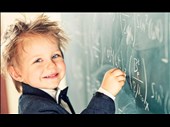Solution for: Children’s literature
Answer Table
| 1. vi | 8. NOT GIVEN |
| 2. x | 9. NO |
| 3. iii | 10. YES |
| 4. viii | 11. NO |
| 5. i | 12. YES |
| 6. iv | 13. NOT GIVEN |
| 7. ix |
Exam Review
Children’s literature

A I am sometimes asked why anyone who is not a teacher or a librarian or the parent of little kids should concern herself with children's books and folklore. I know the standard answers: that many famous writers have written for children, and that the great children's books are also great literature; that these books and tales are an important source of archetype and symbol, and that they can help us to understand the structure and functions of the novel.
B All this is true. But I think we should also take children's literature seriously because it is sometimes subversive: because its values are not always those of the conventional adult world. Of course, in a sense much great literature is subversive, since its very existence implies that what matters is art, imagination and truth. In what we call the real world, what usually counts is money, power and public success.
C The great subversive works of children's literature suggest that there are other views of human life besides those of the shopping mall and the corporation. They mock current assumptions and express the imaginative, unconventional, noncommercial view of the world in its simplest and purest form. They appeal to the imaginative, questioning, rebellious child within all of us, renew our instinctive energy, and act as a force for change. This is why such literature is worthy of our attention and will endure long after more conventional tales have been forgotten.
D An interesting question is what - besides intention - makes a particular story a 'children's book'? With the exception of picture books for toddlers, these works are not necessarily shorter or simpler than so-called adult fiction, and they are surely not less well written. The heroes and heroines of these tales, it is true, are often children: but then so are the protagonists of Henry James's What Maisie Knew and Toni Morrison's The Bluest Eye. Yet the barrier between children's books and adult fiction remains; editors, critics and readers seem to have little trouble in assigning a given work to one category or the other.
E In classic children's fiction a pastoral convention is maintained. It is assumed that the world of childhood is simpler and more natural than that of adults, and that children, though they may have faults, are essentially good or at least capable of becoming so. The transformation of selfish, whiny, disagreeable Mary and hysterical, demanding Colin in Frances Hodgson Burnett's The Secret Garden is a paradigm. Of course, there are often unpleasant minor juvenile characters who give the protagonist a lot of trouble and are defeated or evaded rather than reeducated. But on occasion even the angry bully and the lying sneak can be reformed and forgiven. Richard Hughes's A High Wind in Jamaica, though most of its characters are children, never appears on lists of recommended juvenile fiction; not so much because of the elaborations of its diction (which is no more complex than that of, say, Treasure Island), but because in it children are irretrievably damaged and corrupted.
F Adults in most children's books, on the other hand, are usually stuck with their characters and incapable of alteration or growth. If they are really unpleasant, the only thing that can rescue them is the natural goodness of a child. Here again, Mrs. Burnett provides the classic example, in Little Lord Fauntleroy. (Scrooge's somewhat similar change of heart in Dickens's A Christmas Carol, however, is due mainly to regret for his past and terror of the future. This is one of the things that makes the book a family rather than a juvenile romance; another is the helpless passivity of the principal child character, Tiny Tim.).
G Of the three principal preoccupations of adult fiction - sex, money and death - the first is absent from classic children's literature and the other two either absent or much muted. Money is a motive in children's literature, in the sense that many stories deal with a search for treasure of some sort. These quests, unlike real-life ones, are almost always successful, though occasionally what is found in the end is some form of family happiness, which is declared by the author and the characters to be a 'real treasure'. Simple economic survival, however, is almost never the problem; what is sought, rather, is a magical (sometimes literally magical) surplus of wealth. Death, which was a common theme in nineteenth-century fiction for children, was almost banished during the first half of the twentieth century. Since then it has begun to reappear; the breakthrough book was E.B. White's Charlotte's Web. Today not only animals but people die, notably in the sort of books that get awards and are recommended by librarians and psychologists for children who have lost a relative. But even today the characters who die tend to be of another generation; the protagonist and his or her friends survive. Though there are some interesting exceptions, even the most subversive of contemporary children's books usually follow these conventions. They portray an ideal world of perfectible beings, free of the necessity for survival.
Questions 1-7
Reading Passage has seven paragraphs A-G.
Choose the correct heading for each paragraph from the list of headings below.
Write the correct numbers i-x in boxes 1-7 on your answer sheet.
List of Headings
i Optimistic beliefs held by the writers of children’s literature
ii The attitudes of certain adults towards children’s literature
iii The attraction of children’s literature
iv A contrast that categorises a book as children’s literature
v A false assumption made about children’s literature
vi The conventional view of children’s literature
vii Some good and bad features of children’s literature
viii Classifying a book as children’s literature
ix The treatment of various themes in children’s literature
x Another way of looking at children’s literature
1 Paragraph A
Answer: vi Locate
2 Paragraph B
Answer: x Locate
3 Paragraph C
Answer: iii Locate
4 Paragraph D
Answer: viii Locate
5 Paragraph E
Answer: i Locate
6 Paragraph F
Answer: iv Locate
7 Paragraph G
Answer: ix Locate
Tips: Matching headings to paragraphs
Task guide
► This task requires you to select the most suitable headings for the paragraphs of a reading passage.
► In the list of possible headings that you select from, some of the headings are not suitable for any of the paragraphs of the reading passage.
► This task requires you to decide what the main topic or point of each paragraph is. An option may refer to something that is mentioned in a certain paragraph of the text, but it may not be the correct answer because it is not the main point or topic of that paragraph.
► Beware of 'word spotting'. Do not choose a heading as your answer simply because it contains a word that also appears in a particular paragraph of the text. It is likely that the same word will also appear in other paragraphs.
Step-by-step Guide
The best approach to this task is to read each paragraph of the text one by one, and then look at the list of headings each time to select the appropriate one.
Question 1
► Step 1 - Read the paragraph
Read paragraph A carefully and identify the main topic.
► Step 2 - Consider each option
Look at each option and decide whether it matches the main topic of the paragraph. You will need to ask yourself the questions below in order to answer the question. Questions i-x refer to the corresponding options i-x.
i Is the paragraph mainly about what the writers of children's books believe?
ii Does the paragraph focus on what certain adults think of children's literature?
iii Does the paragraph mainly talk about what features of children's literature make it attractive?
iv Does the paragraph focus on a difference between two things?
v Is the paragraph mainly about something that people incorrectly believe about children's literature?
vi Does the paragraph focus on what people normally say about children's literature?
vii Does the paragraph mainly compare different features of children's literature?
viii Is the paragraph mainly about what causes a book to be classified as children's literature?
ix Is the paragraph mainly about the way various subjects are dealt with in children's literature?
x Does the paragraph focus on a different view of children's literature from one already mentioned?
► Step 3 - Choose the correct option
When you have chosen your answer for paragraph A, check that it is correct by answering this question:
Which word in the heading you have chosen means the same as 'standard' in paragraph A?
Question 2
► Step 1 - Read the paragraph
Repeat step 1 above for paragraph B.
► Step 2 - Consider each option
Repeat step 2 above.
► Step 3- Choose the correct option
When you have chosen your answer for paragraph B, check that it is correct by answering this question: Which word in paragraph B indicates that a point is being made that is additional to a point previously made?
Questions 3-7
Now follow the same process to decide on your answers for Questions 3-7 (Paragraphs C-G):
• Read each paragraph carefully.
• Use the questions in step 2 above to help you choose the correct heading.
Questions 8-13
Do the following statements agree with the views of the writer in Reading Passage?
In boxes 21-26 on your answer sheet unite
YES if the statement agrees with the views of the miter
NO if the statement contradicts the views of the writer
NOT GIVEN if it is impossible to say what the writer thinks about this
8 Adults often tail to recognise the subversive elements in books their children read.
Answer: NOT GIVEN Locate
9 In publishing, the definition of certain genres has become inconsistent.
Answer: NO Locate
10 Characters in The Secret Garden are a good example of the norm in children’s literature.
Answer: YES Locate
11 Despite the language used in A High Wind in Jamaica, it should be considered a children’s book.
Answer: NO Locate
12 The character of Tiny Tim contrasts with that of the child in Little Lord Fauntleroy.
Answer: YES Locate
13 A more realistic view of money should be given in children’s books.
Answer: NOT GIVEN
Tips: Yes/No/Nof Given
Task guide
► This task requires you to understand views expressed or claims made by the writer of the text.
► To answer each question, you will need to ask yourself three questions:
(a) Is the same view expressed in the text?
(b) Is the opposite view expressed in the text?
(c) Is there no view on this particular matter in the text?
► For an answer to be 'No', the writer must directly state something that makes the statement in the question incorrect.
► Questions to which the answer is 'Not Given' involve the writer saying something related to the statement in the question, but not expressing a view or making a claim on the specific point mentioned in the question.
► This task requires you to look very closely at what the writer does say, with regard to each of the questions.
► The questions follow the order in which the relevant issues are discussed or points mentioned in the text.
Step-by-step Guide
The best way to approach this task is to;
• look at each question one by one
• locate the relevant part of the text
• study the question and that part of the text carefully and
• then decide on your answer.
Question 8
► Step 1 - Locate the relevant section of the text
Which section or sections of the text describe children's literature as subversive?
► Step 2 - Study the question carefully
Focus on the place(s) in the text you identified in step 1. Look carefully at the question and decide exactly what it means.
1 What does 'subversive' mean in the context?
A criticising what is considered to be normal
B done only for entertainment
C difficult for some people to understand
2 The question is asking if the author says that adults
A pretend that the books don't have subversive elements.
B are annoyed that the books have subversive elements.
C don't realise that the books have subversive elements.
► Step 3 - Find the answer
Using your answers in step 2, read the relevant part of the text carefully and answer these questions:
1 Does the writer say that children's literature presents a view of life that is different from that of adults?
2 Does the writer say that adults think that a different view of life is presented in the books their children read?
3 Does the writer say that adults read the books their children read?
Now use your answers for steps 2 and 3 to decide on the answer to Question 8.
Question 9
► Step 1 - Locate the relevant section of the text
1 Which section of the text refers to the publishing world and the people involved in it?
2 Which people involved in the publishing world are mentioned there?
3 What two kinds of literature are mentioned there?
► Step 2 - Study the question carefully
Focus on the place(s) in the text you identified in step 1. Look carefully at the question and decide exactly what it means.
1 Which word in the relevant part of the text means 'genre'?
2 The question is asking whether the writer states that something
A isn't always correct.
B has become unfashionable.
C doesn't always follow the same pattern.
► Step 3 - Find the answer
Using your answers in step 2, read the relevant part of the text carefully and answer these questions:
1 Does the writer say that children's books and adult books are still considered to be totally separate types of book?
2 Does the writer say that people find it difficult to decide what category some books belong to?
3 Does the writer suggest that different people categorise books differently?
Now use your answers for steps 1 and 2 to decide on the answer to Question 9.
Questions 10-13
Now answer Questions 10-13, using the same process:
• Locate the relevant part of the text.
• Study the question and the relevant part of the text carefully.
Other Tests
-
Total questions: 14
- 6- YES-NO-NOT GIVEN
- 8- Matching Headings
-
Total questions: 13
- 6- Matching Headings
- 7- Sentence Completion
-
Total questions: 13
- 8- YES-NO-NOT GIVEN
- 2- Sentence Completion
- 3- Plan, map, diagram labelling
-
Total questions: 13
- 9- Matching Information
- 4- Sentence Completion
-
Total questions: 6
- 6- TRUE-FALSE-NOT GIVEN
-
Total questions: 9
- 9- Matching Information











